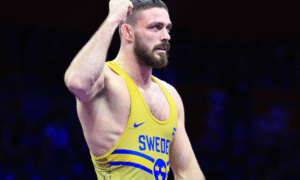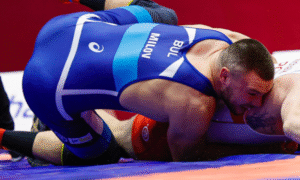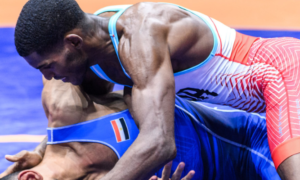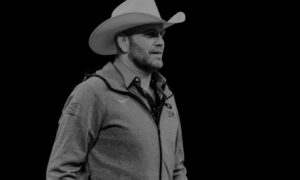Beginning with the 2016 Olympic Team Trials and lasting until selection for the Tokyo Games, 85 kilograms (and later, 87 kg) was deemed one of America’s deepest weight categories — and was without question the nation’s most competitive upper-weight bracket overall.
Overview
The weight division was light on quantity but sufficient in quality when determining the Team for London ’12. At that Trials tournament, Chas Betts emerged as the victor after defeating Jordan Holm in the best-of-three final. Cheney Haight, who was then a returning World Teamer, had been edged by Holm in the semis; Holm went on to clip pseudo-rival Zac Nielsen before staring down Betts. On the top side of the bracket along with Betts were other stout competitors such as Travis Rutt, Mark Stenberg, and two-time World Team member Jake Clark (who was injured in the opening round).
Four years hence, the field had grown. Considerably.
Holm had become the commander of the bracket by having repped the US at the three concurrent World events leading up to the Trials — and Clark had re-entered the fray earlier in the season, picking up an unscored-upon National title in the process. ’12 Olympian Ben Provisor (foiled by Clark in the ’15 National final) was also an obvious threat, but he was not alone. Patrick Martinez (NYAC) had only just begun his ascension, and Jon Anderson (a hero for Team USA at the ’15 Pan-American Games and by then a WTT runner-up) was seen as a big-time candidate. Fresh faces Luke Sheridan (97 kg, Army/WCAP), Kevin Radford, Ryan Hope, and Hayden Zillmer were likewise in the mix. Provisor eventually prevailed over Clark to earn the spot, with Zillmer surprising many observers by taking third. He had not quite yet transformed into a monster though his talent was undeniable.
Turnover did not harm the weight class’ optics in ’17. Gone were Holm, Clark, and Stenberg but nearly everyone else from the ’16 Iowa City Trials had returned, with Joe Rau a last-minute entrant following his run at 98 kg, where Zillmer had landed.
Rau could not compete at the ’18 Trials, for he had been assaulted in the room by Malcolm Allen the week prior and left with an injury. A sizable loss for the bracket, certainly, but there were plenty of reinforcements. Martinez… Provisor… ’16 National champ Radford… Khymba Johnson (NYAC)… JD Souza (Army/WCAP)… Rich Carlson (Minnesota Storm)… Yet again, the depth in terms of viability was more than respectable. And it remained that way for ’19 World Team selection, as well, which was another multi-tiered format and one that ended with Rau decisioning Provisor in two straight at Final X: Rutgers.
Peak & Quick Decline
Autumn of 2019
Throughout the late autumn and early winter of ’19, the expectation was that the 87-kilogram bracket for Tokyo Olympic Team selection might overshadow iterations of its recent past, this despite Provisor declaring his drop to 77. Not only were Rau, Martinez, and Anderson still top contenders, but Carlson and ’17 U23 World Team member Barrett Stanghill had also established themselves as legitimate obstacles. Chandler Rogers had emerged, as well; and, though they had not yet qualified for the Trials, the Marine tandem of Terrence Zaleski and Vaughn Monreal-Berner were gaining ground and garnering recognition. Souza, too, but he had fallen injured and required a lengthy rehabilitation phase.
The hottest new name in the division before (and shortly after) the calendar flipped to 2020 was Carter Nielsen. Younger brother of Zac, Nielsen’s transition to full-time Greco-Roman at Northern Michigan the year prior brought with it placement on the U23 World Team, but at 82 kilos. For the Olympic Year, he moved up to 87 and soon caught fire. At the ’19 Nationals/Olympic Trials Qualifier, Nielsen scorched his way to the semifinal where he was defeated 2-1 by Martinez. Needing to get himself in the top-5, he recovered with consecutive wins on the bracket’s backside over Stanghill and Carlson, respectively. Nielsen subsequently competed at Thor Masters ’20 and finished with a 2-2 record, good for 5th-place.
Effect of the Pandemic
The year-long postponement that was the result of COVID-19’s arrival altered the landscape of 87 kilograms in several critical ways.
By virtue of his qualifying 87 for the US at the Pan-Ams (on March 13), Rau cemented a bye to the best-of-three. The rest of the field would not have changed much compared to its rendering at the ’19 Nationals/Trials Qualifier (which Anderson won due to an injury default by Martinez). Zaleski was the most notable late addition, as he had made the cut after earning gold at the ’20 Armed Forces Championships in February. The only missing pieces would have been from the “Last Chance” Olympic Trials Qualifier. Scheduled for the last weekend in March (Millersville University, PA), Trials spots were available for the top-2 placewinners.
87 KG — Olympic Trials/April 2020
— Rau (bye to final round)
— Anderson
— Martinez
— Rogers
— Nielsen
— Carlson
— Stanghill
— Zaleski
— “Last Chance” winner
— “Last Chance” true second
The pandemic-influenced postponement subtracted athletes from the Olympic Trials bracket as well as added them.
Nielsen, who as mentioned was surging during this time-frame, ultimately (and unfortunately for the US) ceased competing, as did Rogers, another tremendous prospect; and Carlson later deployed with the Minnesota National Guard amid the unexpected allotment of downtime. That is a total of three suitably credible wrestlers who were qualified for the ’20 Olympic Trials but would eventually not appear in the bracket when the tournament was finally held in April of ’21.
The New Four
Throughout this entire interim, Alan Vera (NYAC) was waiting for his paperwork to clear. He had received the sign-off to represent the US in sanctioned international events (and did so for the first time at Thor Masters ’19), but that was only one hurdle. Vera was still unable to enter a US selection process event as of March ’20. There was one appointment on his calendar close to the deadline for “Last Chance” and the subsequent Trials, and it had been canceled due to the pandemic. Because of this, he likely would have missed the April ’20 Trials but, as most are aware, he was fully available to pursue a taste pf domestic success come the proceeding fall. In his first US National tournament, which took place in October of ’20, Vera defeated Rau in the final via decision. He then used the ’21 “Last Chance” as his springboard to the Trials.
’19 World Team member John Stefanowicz (Marines) had originally been associated with 77 kilograms, though he had resisted publicly declaring which weight category he might choose. To be sure, the former 82-kilogram competitor was anticipated to make the drop to 77, where he was seen as an automatic contender. That, coupled with his prior experience in the weight class, underscored that train of thought. A showing at 87 for the ’19 Haparanda Cup did little to cloud this perception. But throughout the darkest stages of the sport’s lockdown, Stefanowicz no longer had to concern himself with questions surrounding his weight. He could have made 77 — but instead, kept the majority of his added bulk and decided that 87 looked more appealing. It turned out to be the correct decision.

Patrick Martinez (red) attempts to turn Jon Anderson in the semifinal round of the 2020 Olympic Team Trials in Fort Worth, Texas. Both athletes greatly contributed to the competitiveness at 87 kilograms in the United States in the aftermath of the Rio quad — but soon following the ’20 Olympic Trials event (contested April of ’21), the depth available in this weight category quickly diminished. (Photo: Tony Rotundo)
Spencer Woods (Army/WCAP) was going to try 77 kilograms entering ’20 after spending most of his time at 82 kilos, the weight class in which he made the ’19 Open final. In fact, 77 was the weight class in which Woods qualified for the Trials (silver at the ’19 Bill Farrell Memorial). Then he joined WCAP. Shortly after Woods acclimated to life at Fort Carson, he began to add muscle, and then he added some more. By the time 2020ne hit, Woods was a bona fide 87 whose first Olympic Trials was a memorable one. He wound up becoming Anderson’s last opponent and later pressed Martinez in the third-place/National Team match.
No longer in this weight category is Christian DuLaney (Minnesota Storm), who has committed to 97. Although a seasoned, very strong competitor, DuLaney was without the lead-up most Seniors had when it came time to for the “Last Chance” event. That did not stop him. DuLaney powered to the final round, his performance punctuated by an impressive decision victory at the expense of ’18 Junior World silver Andrew Berreyesa.
On paper, the revamped 87-kilogram bracket for the postponed ’20 Olympic Trials was still one of Greco-Roman’s strongest. One could surmise that it might have been even more competitive had Nielsen, Rogers, and Carlson remained — but the four athletes who were added later helped sustain the weight category’s reputation.
87 KG — Olympic Trials/April 2021
— Rau (bye to final round)
— Vera
— Anderson
— Martinez
— Stefanowicz
— Stanghill
— Zaleski
— Woods
— DuLaney
A Sudden, Steep Drop-off
The unusual circumstances of an Olympiad and a World Championships occurring during the same year forced the United States to begin another selection process within mere weeks of the ’20 Olympic Trials, a process that began with the US Nationals. Only two wrestlers who were in the 87 bracket at the Olympic Trials less than four weeks prior (Woods and Zaleski) entered the tournament. In what was a 15-man field, Woods took the crown over Tommy Brackett.
Stefanowicz had been awarded the Tokyo spot following his controversial two-match victory over Rau, and both were obviously going to bypass the Nationals no matter what. Vera — whose knee was torn — missed the event, as well, and Martinez required his own time to rest and heal (back/hips). DuLaney would be heard from again, of course, but was likewise absent for the event.
What the ’21 Nationals did was emphasize turnover. Anderson had retired and Stanghill had gone on sabbatical (he is currently considered inactive, not officially retired). As many might recall, Rau and Stefanowicz were headed to arbitration; the assumption at the time was that if the verdict did not favor Rau, then he would walk away — which he did, save for a re-appearance last season in freestyle. Stefanowicz himself has not competed since Tokyo.
By the proceeding September, the 87-kg bracket at the World Team Trials was limited to a paltry five competitors. Woods and Brackett were uninvolved, as both ventured back down to 82. Vera completed his takeover of the spot by sweeping Ryan Epps (Minnesota Storm).
2022 Not Much Better
The ’22 US Open chart for 87 featured ten athletes — on the low end, but a respectable number. Timothy Young (Army/WCAP) and ’18 U23 World Team member George Sikes (NYAC/NTS) were the most significant additions to the mix. But when the World Team Trials Challenge Tournament unfolded the next month, 87 was down to six entrants. The selection process reached its conclusion at Final X: New York where Vera went over Young in two straight. The x-factor not mentioned is Carlson, who had defeated Vera at the April Farrell before making an appearance at the Pan-Am Championships. Carlson would not be seen again until this past November.
Moving Forward
Time is of the essence for 87 kilograms due to one, exceedingly important reason: Olympic qualifying.
The 2023 World Championships (Belgrade, SRB) will offer the first opportunity nations have to attain quotas in the six Olympic weight categories. In order to achieve the directive of Paris Qualification, either in Belgrade or via the Pan-American Qualifier or World OG event, it is likely that an increase in domestic depth will be necessary for the United States. An underwhelming number of entrants at the US Open or a six-man bracket at the World Team Trials would fall woefully short of appropriately serving such an objective. Which is a possibility; with 82 kilograms still an option for athletes in ’23, some may be hesitant to tack on size if they identify 82 as the more amenable route towards World Team selection.
Vera is the undisputed #1 athlete at 87, as well as the bracket’s most technically-proficient competitor. But he has a problem: outside of his defeat to Carlson last April (a match in which he was leading 7-0 before Carlson’s incredible throw-pin), Vera has not been seriously tested since the ’20ne Olympic Trials. What he needs (and desires) personally, and what the US requires in totality, is for an influx of competitors at 87 kg who have the capacity to pose fitful challenges, if not directly threaten to commandeer the ’23 World Team spot.
The good news is that there is reason to believe 87 kilograms might regain at least some of its lost steam this very season. And while Stefanowicz and Martinez by themselves would, immediately and mightily, improve the division’s level of competitiveness simply by registering for a tournament, there are others who wield the potentiality to rock the proverbial boat. In a good way. And the best part is that they are all young and familiar.
Spencer Woods (Army/WCAP) — Whether he chooses this season or next to revisit 87, Woods is perhaps the most dangerous name on the list for Vera. Now experienced in his own right on the World level, “The Alaskan Assassin” has gained a firmer grasp of the more critical aspects present in the sport internationally. He has also increased in size and strength (even at 82 kg), and displays explosiveness to spare. Woods brings to bear a touch of unorthodox tactics, as well, which combined with his high motor make him a nightmare match-up for just about everyone.

Flanked by Army coaches Spenser Mango (left) and Bruce Robinson (right), Spencer Woods makes his way to the mat for the first round of the 2022 World Championships this past September in Belgrade, Serbia. (Photo: Tony Rotundo)
Timothy Young (Army/WCAP) — Is already recognized as one of the best upper-weight prospects in recent memory. Consider: most of what the masses have seen out of Young thus far is the rawest version of his abilities. In other words, if you have watched Young wrestle Senior Greco, all you have witnessed is the surface barely getting scratched. Yet — last season, he placed third at the Open and was Vera’s Final X runner-up. Once Young fully matriculates into the Army room where he will have caring, professional coaches and a wealth of training partners (including Woods), his stock will skyrocket.
Tommy Brackett (Unattached) — The most classical pummeler of his generation in the US, and one of the smoothest operators in space for those who take his body composition for granted. Brackett’s posture and movement are his biggest assets, and they have to be due to his short stature. He excels when it comes to making opponents move an extra step or two, which causes constant resets in what would appear to be otherwise advantageous positions for the other guy. As Brackett has grown and improved, he has also begun to demonstrate more conviction in his attacks, which is vital in the US given how matches are officiated. As a recent U23 World Team member and Senior Open/Trials runner-up, he cannot be overlooked.
Ty Cunningham (MWC) — ’22 was a very productive first year on the Senior level for Cunningham, who was also the U23 World Team rep. He accumulated a lot of meaningful match time, an endeavor that began with a then-upset win over Epps for Farrell bronze in April and ended with another win against Epps for Farrell gold last month. In between, Cunningham was a player at every tournament he entered — but like Woods, Brackett, and Epps, all of those performances occurred one weight class lower. He has the frame to fully blossom at 87 quickly, which he might want to consider instead of waiting an entire season to pass so as to ensure that his strength, mechanics, and general body awareness are in place prior to the ’24 Olympic Trials.
Ryan Epps (Minnesota Storm) — Epps has all of the pieces one could want in an American Greco-Roman athlete. He is driven, powerful, an excellent “total wrestler”, beholden to uncommon stamina, and quite possibly the most tenacious competitor in this weight range. These attributes helped Epps make a severe impact in ’21, when he reached both the National and Trials finals — at 77 and 87, respectively. However, that Trials performance at 87 was a touch misleading insofar as he was markedly underweight. This past season, Epps focused on 82 and was unable to replicate the same degree of domestic success. Part of that is on him and him alone, and part of that is because the pool at 82 was deeper than Olympic 87. So long as he is not entertaining thoughts of dropping down, a bigger, badder, and more experienced Epps should deliver significant issues to his contemporaries come time for Paris selection.

Ultimately, 87 kilograms is not about Vera, or if Martinez and Stefanowicz will return and in a flash contend for the Olympic Team spot. Right now, as in December of 2022, the priority for the United States program is working towards ensuring that there is a representative in this weight category at the ’24 Paris Games. Qualifying for an Olympic license is #1 on the list. It is that way for every national federation, and, depending on the year, can prove a tremendously challenging process, particularly when it is not achieved on the first try at a World event.
Such a difficult proposition qualifying often is that heaping it all upon the shoulders of one athlete is the opposite of a successful recipe. In this light, one might do well to view the wrestlers as gears in the same machine. Although they may pursue individual objectives, each according to his own talents and abilities, they can only achieve as high as the demonstrated standard. The only way for that standard to be raised, competitively, is when more gears are introduced that which incite the machine to improve production.
So it is not about Vera, or P-Mart, Stefanowicz, and Woods. It is about all of the wrestlers in this weight category. Because all of them equal what it will take for 87 kilograms to recapture its previous standing in the US. All of them involved represent America’s best chance to qualify this weight class for the upcoming Olympiad.

Listen to “5PM52: Two-Time Olympian Jim Gruenwald” on Spreaker.
Listen to “5PM51: Lining up with Tanner Farmer” on Spreaker.
SUBSCRIBE TO THE FIVE POINT MOVE PODCAST
iTunes | Stitcher | Spreaker | Google Play Music





















